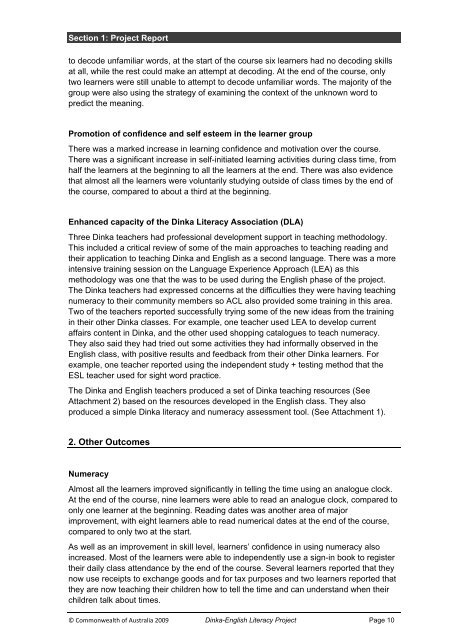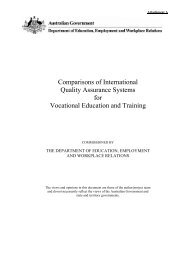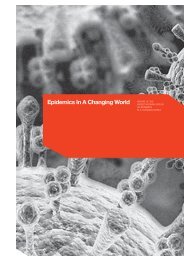First Language (Dinka) Literacy as a Foundation for English ...
First Language (Dinka) Literacy as a Foundation for English ...
First Language (Dinka) Literacy as a Foundation for English ...
You also want an ePaper? Increase the reach of your titles
YUMPU automatically turns print PDFs into web optimized ePapers that Google loves.
Section 1: Project Report<br />
to decode unfamiliar words, at the start of the course six learners had no decoding skills<br />
at all, while the rest could make an attempt at decoding. At the end of the course, only<br />
two learners were still unable to attempt to decode unfamiliar words. The majority of the<br />
group were also using the strategy of examining the context of the unknown word to<br />
predict the meaning.<br />
Promotion of confidence and self esteem in the learner group<br />
There w<strong>as</strong> a marked incre<strong>as</strong>e in learning confidence and motivation over the course.<br />
There w<strong>as</strong> a significant incre<strong>as</strong>e in self-initiated learning activities during cl<strong>as</strong>s time, from<br />
half the learners at the beginning to all the learners at the end. There w<strong>as</strong> also evidence<br />
that almost all the learners were voluntarily studying outside of cl<strong>as</strong>s times by the end of<br />
the course, compared to about a third at the beginning.<br />
Enhanced capacity of the <strong>Dinka</strong> <strong>Literacy</strong> Association (DLA)<br />
Three <strong>Dinka</strong> teachers had professional development support in teaching methodology.<br />
This included a critical review of some of the main approaches to teaching reading and<br />
their application to teaching <strong>Dinka</strong> and <strong>English</strong> <strong>as</strong> a second language. There w<strong>as</strong> a more<br />
intensive training session on the <strong>Language</strong> Experience Approach (LEA) <strong>as</strong> this<br />
methodology w<strong>as</strong> one that the w<strong>as</strong> to be used during the <strong>English</strong> ph<strong>as</strong>e of the project.<br />
The <strong>Dinka</strong> teachers had expressed concerns at the difficulties they were having teaching<br />
numeracy to their community members so ACL also provided some training in this area.<br />
Two of the teachers reported successfully trying some of the new ide<strong>as</strong> from the training<br />
in their other <strong>Dinka</strong> cl<strong>as</strong>ses. For example, one teacher used LEA to develop current<br />
affairs content in <strong>Dinka</strong>, and the other used shopping catalogues to teach numeracy.<br />
They also said they had tried out some activities they had in<strong>for</strong>mally observed in the<br />
<strong>English</strong> cl<strong>as</strong>s, with positive results and feedback from their other <strong>Dinka</strong> learners. For<br />
example, one teacher reported using the independent study + testing method that the<br />
ESL teacher used <strong>for</strong> sight word practice.<br />
The <strong>Dinka</strong> and <strong>English</strong> teachers produced a set of <strong>Dinka</strong> teaching resources (See<br />
Attachment 2) b<strong>as</strong>ed on the resources developed in the <strong>English</strong> cl<strong>as</strong>s. They also<br />
produced a simple <strong>Dinka</strong> literacy and numeracy <strong>as</strong>sessment tool. (See Attachment 1).<br />
2. Other Outcomes<br />
Numeracy<br />
Almost all the learners improved significantly in telling the time using an analogue clock.<br />
At the end of the course, nine learners were able to read an analogue clock, compared to<br />
only one learner at the beginning. Reading dates w<strong>as</strong> another area of major<br />
improvement, with eight learners able to read numerical dates at the end of the course,<br />
compared to only two at the start.<br />
As well <strong>as</strong> an improvement in skill level, learners’ confidence in using numeracy also<br />
incre<strong>as</strong>ed. Most of the learners were able to independently use a sign-in book to register<br />
their daily cl<strong>as</strong>s attendance by the end of the course. Several learners reported that they<br />
now use receipts to exchange goods and <strong>for</strong> tax purposes and two learners reported that<br />
they are now teaching their children how to tell the time and can understand when their<br />
children talk about times.<br />
© Commonwealth of Australia 2009 <strong>Dinka</strong>-<strong>English</strong> <strong>Literacy</strong> Project Page 10
















